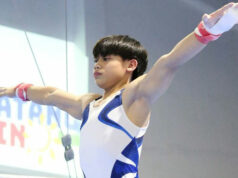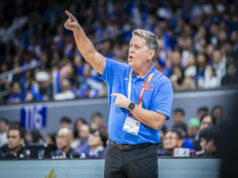Clothing takes a back seat to self-promotion at NY Fashion Week
AT 6 P.M. last Tuesday, for one of the final shows of New York Fashion Week, a throng of photographers and a file of eager spectators mobbed a side street in Manhattan’s Greenwich Village. The garage door of 16 Morton St. was then raised to reveal 16 models perching on porch swings.
They were wearing Cynthia Rowley’s perfectly lovely spring collection, which was sheer, sporty, and exactly on trend. “Dream a Little Dream” gently drifted from the loudspeakers as fashion-week regulars stormed the scene. A perplexed onlooker asked, “Why are people so excited to take pictures of people swinging on swings?”
Because it was New York Fashion Week, of course. The goal of the enterprise is to sell clothes, but more than ever, the events of fashion week found people selling ancillary products — wines, and cars, and most of all themselves as the influence of influencers reached a fever pitch.
Sure, the runways were filled looks that extended and amplified the hottest looks of the current season. There were denim (Alice+Olivia), double denim (Tom Ford), and head-to-toe denim fantasias (Oscar de la Renta). There were pinks that ranged from pretty (Cinq a Sept) to shocking (Christian Siriano). Sheer tops, shown by everyone and showing everything, also ruled.
But with some of America’s most notable designers (Thom Browne, Rodarte, Rick Owens) instead showing in Paris, and with those who remained also increasingly showing men’s clothing, the emphasis on digital spectacle was more spectacular than ever. It felt like a shift, small but meaningful, in the nature of the event, as if NYFW had moved from the Baroque era ushered in by the ascent of Instagram into a manic Rococo phase. It’s always been a zoo, but now the zookeepers are frantically touting their tie-ins, collaborations, and synergies.

It is now, for instance, a place where — allowing exceptions for Nicki Minaj and various Jenner-Kardashians — the reigning celebrity is NBA star Russell Westbrook. Omnipresent, Westbrook used the week as a platform to launch a coffee table book, Style Drivers, via a Q&A at the 16th St. outpost of Barneys New York. His answers were circumspect enough for any post-game interview. Who was his own personal style icon? “My mom.”
On Sunday night, I went to La MaMa Experimental Theater to experience the synergy at its most restrained. Opening Ceremony presented its spring line by way of a dance performance created by film director Spike Jonze and starring actors Lakeith Stanfield (Atlanta) and Mia Wasikowska (Crimson Peak).
True, the full title of the presentation was Opening Ceremony & American Express Platinum present ‘Changers’ and you could buy a $45 T-shirt celebrating it on the way out. But it was as thoughtful and tasteful as the company’s knitwear.
Further downtown, at Fulton Market, there was a party to celebrate the designers of the streetwear brand Public School and a bottle they’d crafted for Moët & Chandon. The event was like a full-employment plan for semi-pro Instagrammers. Naturally, it involved a drinking fountain gurgling with pink Champagne.
This presentation of sparkling wine was positively high-falutin’ compared with that at Rowley’s. There, when I grabbed a glass of prosecco, the cater-waitress smiled and said, “This is Christie Brinkley’s new line,” adding, “You can go on wine.com to order.”

Still wondering what it would take for the big Champagne bubble of the new NYFW reality to burst, I caught up with Rowley after she had pulled the hem of her floor-length dress out of the back of a fan set on the floor. “I like a big adventure,” she said. “I like sports. I like daring feats… For me, all those things combined with a fun, free-spirited feeling about” — here, a well-wisher passed by — “thanks for coming! Sorry it’s so crazy.”
But this was hardly the craziest event of the week. That award went to Alexander Wang, who summoned the fashion press for an event dubbed #Wangfest on a dead-end street in Bushwick, Brooklyn, and then asked them to wait for 75 minutes until his models arrived, via party bus, in lackluster sportswear. The brutality of the reviews still ring: “The collection shown Saturday night was such a side note to the unwieldy, confusing event, it’s barely worth discussing.”
While other journalists were interviewing Wang in “a movie-set trailer that smelled of vomit,” I was outside the Hammerstein Ballroom in Manhattan, navigating a rugby scrum to gain entrance to the Philipp Plein show. Because guests had dressed in a way that matched Plein’s vision of excess, the press of bodies-upon-bodies in the overflow crowd on 34th Street created an interesting texture of metal studs, black leather, and blue mohair.
Inside, the hectic scene transferred to a spectacle that went heavy on dance, with solo performances from Dita Von Teese (the burlesque star and glamour model) and Teyana Taylor (the hip-hop multi-hyphenate who memorably gyrated in Kanye West’s “Fade” video) and chorus girls who dressed in boots and bodysuits and evidently learned their choreography at Scores.
At Plein’s afterparty (also at Hammerstein, with Nicki Minaj performing), as at Wang’s, bartenders relied on Red Bull as the mixer of choice. Call it the official sponsor of the most overcaffeinated fashion week in history. — Troy Patterson, Bloomberg



